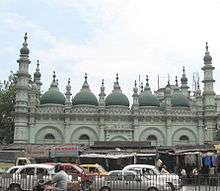Tipu Sultan Mosque
| Tipu Sultan Mosque | |
|---|---|
 | |
| Basic information | |
| Location |
|
| Geographic coordinates | 22°33′55″N 88°21′06″E / 22.5653°N 88.3518°ECoordinates: 22°33′55″N 88°21′06″E / 22.5653°N 88.3518°E |
| Affiliation | Islam |
| District | Kolkata |
| Province | West Bengal |
| Ecclesiastical or organizational status | Mosque |
| Architectural description | |
| Architect(s) | Prince Ghulam Mohammed |
| Architectural type | Mosque |
| Architectural style | Islamic, Mughal |
| Completed | 1842 |
| Specifications | |
| Direction of façade | South |
| Capacity | 1,000 |
| Dome(s) | 16 |
| Minaret(s) | 4 |
The tipu Sultan Shahi Mosque (also known as Tipu Sultan Masjid) is a famous mosque in Kolkata, India.[1][2] Located at 185 Dhartamtalla Street, the mosque is a relic of architectural and cultural heritage. People from all sections of society and religions are allowed to visit and take pictures of this historical premises.
Construction
This building was built in 1832 by Prince Ghulam Mohammed, the youngest son of Tipu Sultan. An identical mosque built later by the waqf committee is at Tollygunge.
Restoration efforts
The Tipu Sultan Shahi Masjid Protection & Welfare Committee was founded in the late 1980s by Seraj Mubarki, Mohammad Sharfuddin, Izhar Khan and Syed Zafar to motivate and educate people about the damage caused to the masjid by the Metro railway. This committee is headed by Mohammad Sharfuddin as its chairman.
The committee was established to negotiate with the Kolkata Metro authorities to repair the damage caused by the construction underneath the building. The authorities agreed to demolish the damaged part of the mosque and rebuild it.
Community relations
The Tipu Sultan Shahi Masjid Protection & Welfare Committee, under the guidance of Janab Sami Mubaraki, the incumbent chairman, continues to play an active role in the daily affairs of the mosque. Committee members raised INR 21,501 for the 2004 Tsunami victims as part of the Prime Minister's Tsunami fund.
The committee went on a five-day hunger strike to seek the intervention of the central government when a Muslim dargah and a Hindu temple were ruined in Vadodara. The fast was later broken with an initiative by H.E. Honorable Governor Shri. Gopal Krishna Gandhi who offered glass of juice to the fasters and later condemned attacks on Hindu temples in Pakistan and the attacks on Christian missionaries in Orissa and other parts of India.
See also
- Islamic architecture
- Islamic art
- Sahn
- Timeline of Islamic history
- Haqqani Masjid of Haqqani Anjuman
References
- ↑ Swati Mitra (2011). Kolkata: City Guide. Goodearth Publications. pp. 43–. ISBN 978-93-80262-15-4. Retrieved 11 July 2012.
- ↑ Joe Bindloss (1 October 2009). Northeast India. Lonely Planet. pp. 111–. ISBN 978-1-74179-319-2. Retrieved 11 July 2012.
External links
| Wikimedia Commons has media related to Tipu Sultan Mosque. |

